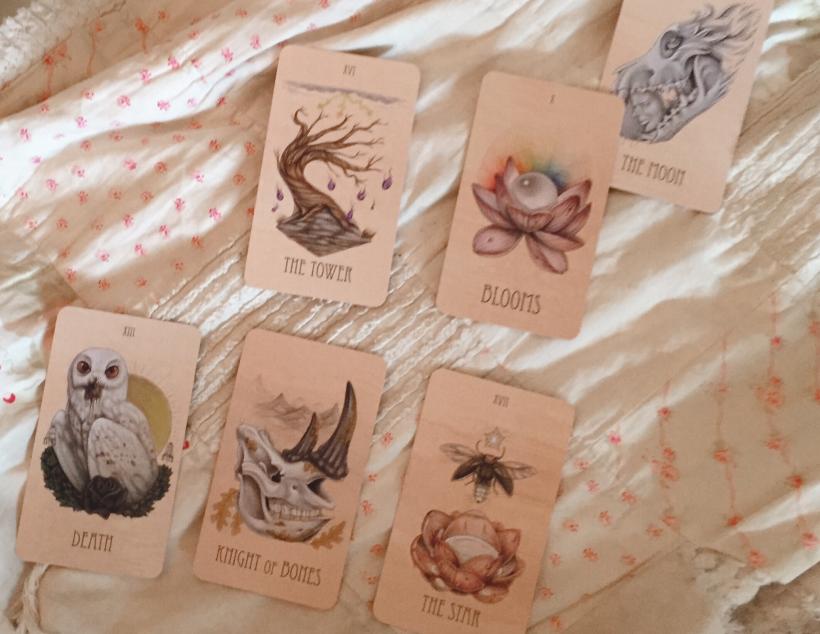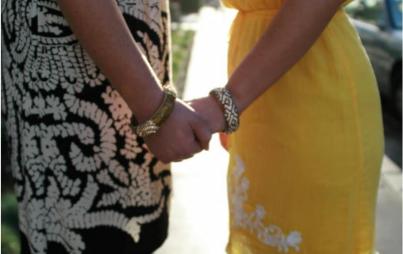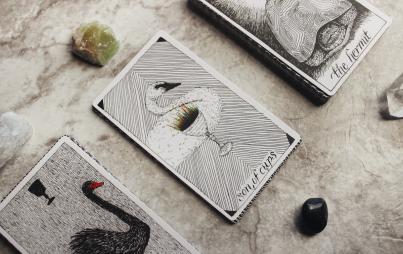
It was the night before my father’s funeral that I finally asked the tarot for help.
CN: abuse, suicide mention, death, substance abuse
I bought my favorite tarot deck two days after my dad died. I ordered it while I was lying next to my 10-year-old little brother in the California King my parents had slept on when they were together. I kissed his sweet head and told him that I wasn’t sure if things would get better, but I did have a feeling that they’d get less hard.
I am programmed to start this story by telling you about how much I loved my father, what a good man he was, and how deeply he loved me in return. As a little kid, I would compulsively preface anything I said about my dad with those things, often so exhaustively that I wouldn’t actually talk about the thing I wanted to say. I still believe to my very core that those things are true.
My dad was a good man — a good man who struggled with an opioid addiction on and off for my entire childhood. A man who was very, very scary a lot of the time.
And he loved me — he loved me so much that he’d take me on vacations and to concerts and then sometimes call me to pour hot poison in my ear about how bad I was at being his daughter.
All of that is true — the love and the abuse, the good and the bad, and the many moments that defy the good/bad binary entirely.
But the happy, easy parts of my life with my dad are not what brought me to tarot, which in turn brought me to my self. It was the dark things, the hard things, the things that I was expressly forbidden to speak about that brought me to the cards I’ve used to begin loving and healing those shadows.
You Might Also Like: Stop Beating Yourself Up — You're Doing Your Best
Six months before my father’s death, I was crammed into the guard-railed top frame of a childhood bunk bed that my little brother slept on as he heaved gasping sobs into my chest at the thought of our father moving to Utah without saying goodbye. He was leaving because he couldn’t be in this town with our mom; it hurt him too much. The next day, he was going to relocate a couple of states away to get some clarity.
Two days later, he’d decide to stay. Then he was leaving. Then staying. It kept going like this for a while. Threatening to leave, often in ways that hinted at or included harming himself, was one of my dad’s failsafe manipulation tactics.
I can only describe living in the sort of chaos such threats create as if someone were to play tennis using your heart as the ball and your soul as the net, except that the match never really stops and nobody has any hope of winning.
In the last year or so of his life, my father relapsed on opioids in a way that I hadn’t seen since I was a little girl — since I was my brother’s age. It shook me awake from a dreamy haze where I pretended he was sober, a fantasy that required me to spend a significant portion of my energy both banishing and idealizing my memories of a pill-addled version of him chasing tiny me down hallways and threatening suicide if I didn’t do what he wanted.
I tried to ignore it. And then it just wasn’t safe to ignore it anymore. I reached a point where I had to choose either myself or my role as his daughter, and I chose me. For the first time in my life, I let my relationship with my dad not be on good terms.
And then he died.
His official cause of death was a pulmonary embolism, but I had watched him die for a long time. I had grown up seeing him slowly poison himself. Losing him was the nightmarish, desperate, gasping fear that had lived in my heart for so long.
It was the night before my father’s funeral that I finally asked the tarot for help.
I was incapable of imagining a future where I delivered his eulogy without sobbing uncontrollably before lapsing into catatonia and gazing into the wood grain of the very same podium where he’d given talks on Mormon history and theology. I had fiddled with tarot before, and even though I was deeply fascinated and moved by the idea of using cards to access the deepest parts of our minds, I couldn’t manage to ever really connect with it myself. I bought The Wooden Tarot deck in a desperate effort to give tarot (and anything, really) another shot.
Instead of cups (water), swords (air), wands (fire), and pentacles (earth) — the minor arcana that make up most of the standard 78 card deck — the Wooden Tarot uses blooms, plumes, stones, and bones, respectively. Puzzling this out (along with the fantastical illustrations of gorgeously warped plants and animals) required enough of the front parts of my brain that my subconscious had room to bubble up to the surface. As I looked at the cards I’d pulled for funerary wisdom that night, the illustrations slowly came to represent aspects of my past and my psyche that my mind rarely allowed me full access to.
The information I got from just three cards was so overwhelming that I was still writing out my feelings about them a full day after the funeral was over. My final card had been the Knight of Bones, a chilling image of a rhino’s skull covered in lichen and fungus from exposure.
I’d pulled the card for help with “dealing with other people” at the funeral, but I was only asking about one person in particular, and he was inside of an urn.
Each suit of the minor arcana has four court cards apiece: a King, Queen, Knight, and Page. Knights go out and do things; they are warriors who quest in the spirit of the element that they embody, and they’re profoundly good at it — legendary, you could say. (If you ever struggle with tarot meanings, just try to match the cards up with stories you know, then remember that these cards just happen to be telling your story instead.) I normally see aspects of myself in each court card, especially Queens and Pages. But the Knight of Bones was and is my father.
The Knight of Bones still comes to visit me when I’m overlooking the complexity of my grief, when I wander too far into any one narrative about it.
Earth, the element we return to when we die, rules the Knight of Bones.
The rhino that once lived inside that skull is dead — extinct, even — but it’s covered in new life. And with all the flesh gone, it looks less like a charging menace and more like a cave carved by time and weather. Seeing it reminds you that nature is brutal and tragic and unforgiving, which makes surviving it long enough to leave behind something beautiful a precious victory.
The Knight of Bones is ancient and immediate, carnal and mythic, protector and destroyer, father and daughter.
The Knight of Bones is my dad and my relationship with my dad. Earth is what we sense and experience, all that which our bodies carry our souls through. The Knight of Bones is a practical, pragmatic, profound truth, embodied and acted out before your eyes.
It’s not useful to me to sanitize my father’s story; it’s also not what he would have wanted. The Knight of Bones gets down in the dirt.
My dad always reminded me to consider every side of something, to look for the unseen and the forgotten. It wasn’t until he visited me on the face of a card that I understood looking there would lead me to find myself.
When I draw the Knight of Bones, I’m filled with tenderness for my dad’s life and gratitude for his legacy. As I was drawing cards to guide myself through this essay, he fell out of the deck.
♦♦♦
I bought myself this deck because I was sad and wanted something beautiful to look at.
I bought it because I was destroyed and willing to try whatever I could to help myself heal.
I bought it because the thought of shuffling cards and learning their complex hidden rules reminded me of curling into my dad’s lap for whole afternoons as we watched Professional Poker together.
I bought them for the reborn version of myself that I was getting to know.
I bought them for the little girl cowering at the end of the dark hallway, so lonely and so scared.
Some witches will tell you a “real” tarot deck is given to you as a gift, and it’s a truth eclipsed by a snobbish lie: all the best gifts in life are the ones you learn to give to yourself.
There were so many reasons why I felt drawn to tarot, but I think at the heart of it all, I saw them as a way back to my intuition. For a very long time, the most intuitive thing I could manage was intuiting that somewhere in me, I had intuition. I could feel the debilitating complex trauma waiting to be healed inside of me, but it had been blocked by years of gaslighting, doubt, and confusion.
Tarot is teaching me to dive deeper, to do what scares me, to realize that I have all the answers I need. Its wisdom is a big, messy spiral of challenging lessons that feed my soul if I’m awake enough to see them — just like life.
Spirals are anything but linear, and I still spend a lot of time feeling like there’s a thick plate of glass between myself and my healing. But I’ve started to slip cards from the Wooden Tarot into any crack I can find. The Knight of Bones was that first courageous ranger to make it through.







